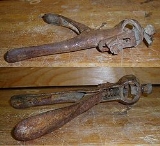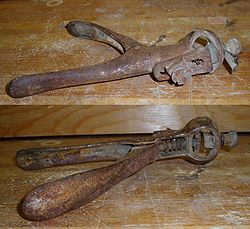
Saw set
Encyclopedia

Sharpening
Sharpening is the process of creating or refining a sharp edge of appropriate shape on a tool or implement designed for cutting. Sharpening is done by grinding away material on the implement with an abrasive substance harder than the material of the implement, followed sometimes by processes to...
of hand saws. Once the teeth have been jointed and filed, the saw set is used to adjust the set
Saw
A saw is a tool that uses a hard blade or wire with an abrasive edge to cut through softer materials. The cutting edge of a saw is either a serrated blade or an abrasive...
of each tooth.
In the past, many tradesmen
Tradesman
This article is about the skilled manual worker meaning of the term; for other uses see Tradesperson .A tradesman is a skilled manual worker in a particular trade or craft. Economically and socially, a tradesman's status is considered between a laborer and a professional, with a high degree of both...
and craftsmen would sharpen their own saws and a saw set would be a common tool to find in the toolbox. In more recent times, modern hand saws are considered disposable and are rarely sharpened.
Explanation
The word 'set' when used in regard to saws has several meanings. It is simultaneously the amount of bend of a saw tooth, the operation of bending a tooth or teeth and the tool used to produce the bend. Most commonly, the 'set' is the amount by which the tooth protrudes from the side of the blade. Most saws have some amount of set, which creates a slot kerfKerf
Kerf and similar can mean:* kerf, the width of a cut* Kerf, a poetry collection by Peter Sanger* Kerala E.N.T. Research Foundation , a hospital at Kollam in Kerala in India...
that is wider than the blade and thereby prevents binding as the non-cutting part of the saw blade enters the cut. This makes it easier to make the cut and allows more control over direction. The amount of set is a compromise between the size of the kerf and the ease of cutting. Carpenter's hand saws have alternate teeth set in opposite directions so that an equal number of teeth protrude from each side of the blade. Crosscut and some circular saws have different arrangements because not all of their teeth cut.
Set must be identical and small. If set varies, the cut is wavy on each stroke. If too large, the cut wanders from a desired line; the saw is difficult or impossible to control. Too much wood is removed, tiring the worker. If too small, the saw binds or is very difficult to use.
Saws with insert teeth use teeth made wider than the blade to get the same result; a saw that cuts easily and smoothly by making the kerf wider than the blade. Another technique, swaging, deforms the tooth so it is wider at its tip than its base.
Forms of a saw set
From 1810 to 1925 almost 900 different saw sets were patented. Todd Friberg "Patented American Saw Sets" Osage Press. The earliest ones were a slot in an iron bar (wrest). A common form of a saw set is a device which resembles a pair of pliersPliers
Pliers are a hand tool used to hold objects firmly, for bending, or physical compression. Generally, pliers consist of a pair of metal first-class levers joined at a fulcrum positioned closer to one end of the levers, creating short jaws on one side of the fulcrum, and longer handles on the other...
. In use, the head of the saw set is located on the blade adjacent to the tooth to which set is to be applied. The handles of the saw set are squeezed together and a hardened steel plunger forces the tooth in the desired direction.
The later saw sets are generally of a 'pistol grip' configuration. With one movement of the handle, a dual action mechanism first locks the saw set around the blade then the plunger bends the tooth as above.
There are even saw sets that set more than one tooth at a time. Another popular design used a captive hammer, often spring-loaded.
Most saw sets have an adjustment screw which allows the amount of set to be determined by the location of a hardened steel plate (anvil) on the opposite side of the device to the plunger. The plunger pushes the tooth against this plate.

